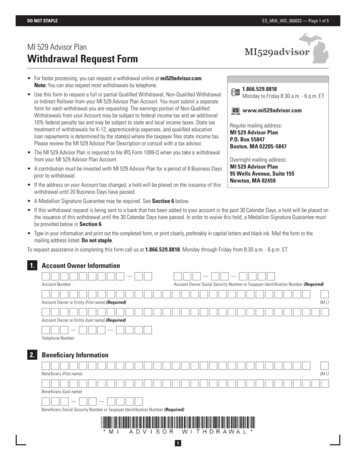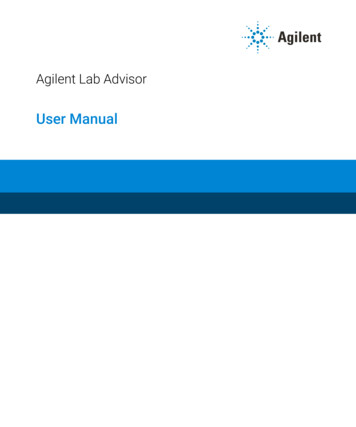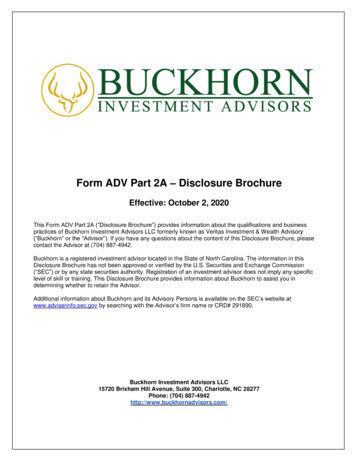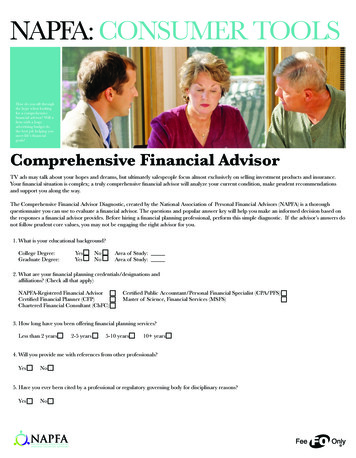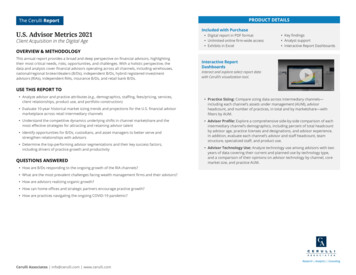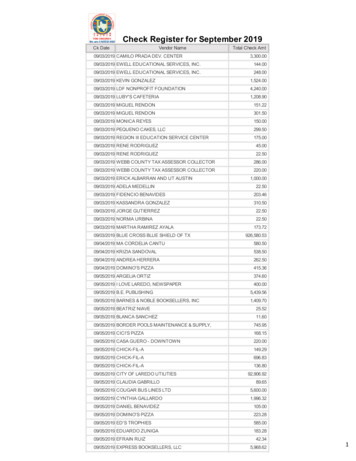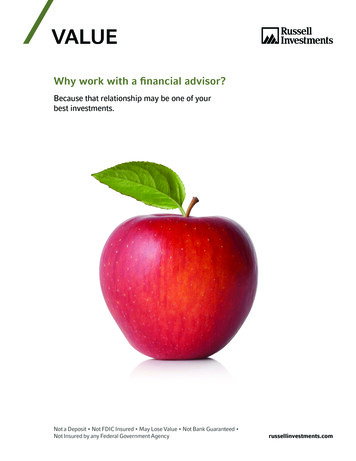
Transcription
VALUEWhy work with a financial advisor?Because that relationship may be one of yourbest investments.Not a Deposit Not FDIC Insured May Lose Value Not Bank Guaranteed Not Insured by any Federal Government Agencyrussellinvestments.com
Why work with a financial advisor?Like many investors considering working with a financial advisor, you probably wonderwhat you would get for the fee you will pay. After all, the S&P 500 Index has experienceda 10-year record-length bull market, so how hard can it be to throw together a winningportfolio?With the wealth of information at our fingertips, you may think you understand the marketsenough to invest for yourself or that getting a financial professional to manage your assetsis expensive. You might feel that a robo-advisor is all you need: for a minimal fee you canselect your investment portfolio and monitor it regularly.However, investment selection and monitoring is just one part of an advisor’s value.Understanding the markets doesn’t necessarily help you invest in them logically. Investingcan be challenging and emotional responses in periods of volatility have the potential toundo years of past or potential gains in your portfolio.Advisors can assist you in a full 360-degree spectrum of wealth planning, from investments,to managing your portfolio through different life changes, to retirement and estateplanning, as well as guidance on potential tax implications of your investments—in orderto help you work toward your financial goals. But more than that, they can act as behaviorcoaches: guiding you through your emotional responses to help ensure your portfolioremains on track.We have developed a formula that can help you understand the value of working with anadvisor.AAnnual rebalancing ofinvestment portfoliosBBehavioral mistakesindividual investorstypically makeCCost of basicinvestment-onlymanagementPPlanning costs &ancillary servicesTTax-smart planning& investing Value of an advisor 2 /Why work with a financial advisor? / Russell Investments
Ais for Annual rebalancingWhen markets are rising, it can be easy to underestimate the importance of disciplined rebalancing.What is rebalancing? Technically, it is the periodic buying and selling of assets in your portfolio tomaintain your originally desired asset allocation—or mix of investments.We believe there are two reasons that many investors don’t rebalance if left to their own devices:1. Because it’s an easy thing to forget to do. Investors know they’re supposed to do it. We alsoknow we’re supposed to change the batteries on our smoke alarms once a year. But do we reallydo it?2. Because, in many cases, rebalancing may be the equivalent of buying more of what’s beenhurting my portfolio and selling what’s been doing well. It may run counter to what an investor’sgut feelings are telling them they need. Rebalancing takes discipline. Your advisor can helpdeliver that discipline and help position your portfolio for long-term success.We believe rebalancing is a vital service, because it helps you remain on track with your plan,avoiding unnecessary risk. You may have started out with a balanced portfolio of 60% stocks and40% bonds, but under certain market conditions that ratio can change significantly. As you can seefrom the illustration below, without rebalancing, over the years your balanced portfolio could endup looking like a growth portfolio—with a much larger exposure to U.S. stocks and a much-smallerexposure to bonds than you had originally determined. This leaves you with a greater exposure tothe risk of any potential sharp shock in U.S. stocks.When balanced becomes the new growthThe potential result of an un-rebalanced portfolioJanuary 1, 2009December 31, 7%5%REAL ASSETSU.S. Large Cap GrowthU.S. Large Cap ValueU.S. Small Cap ValueInt'l Developed EquitiesEmerging Markets EquityGlobal Real EstateFixed IncomeHypothetical analysis provided above for illustrative purposes. Index returns represent past performance, are not aguarantee of future performance, and are not indicative of any specific investment. Source: U.S. Large Cap Growth:Russell 1000 Growth; U.S. Large Cap Value: Russell 1000 Value; U.S. Small Cap: Russell 2000; International Developed:MSCI World ex USA; Emerging Markets Equity: MSCI EM; Global Real Estate: FTSE EPRA NAREIT Developed: FixedIncome: Bloomberg Barclays U.S. Aggregate Bond.The difference may seem small, but the simple act of rebalancing can help capture gains, reducevolatility, and help your asset allocation remain in the range you initially determined was right foryour desired outcome.Russell Investments / Why work with a financial advisor?/ 3
Bis for Behavioral mistakesWe like to think we make rational and logical decisions when we are investing. Butresearchers in the fields of economics, psychology and neuroscience have cast doubts onthat assumption. They have uncovered over 200 types of unconscious biases in humansthat lead us to make decisions that can ultimately jeopardize the health of our wealth—ifleft unchecked.Most people act like humans, not investors. People tend to let their emotions and otherhuman tendencies influence their decision-making. In many parts of life, that’s perfectlyreasonable. But when it comes to investing, acting like a human may actually cost youmoney.To be a successful investor, it is important to be objective and disciplined when makinginvestment decisions. This means making sure decisions align with your long-term goals.While you would be forgiven if tightening U.S. monetary policy, global trade war escalation,and uncertainty over Brexit prompted you to second-guess your investment strategy,making changes off the back of these events may be detrimental to your portfolio.Guarding against mindless investing3 common human mistakes to watch out forOverconfidenceHumans tend toover-estimateor exaggerateour ability tosuccessfullyperform tasksHerdingHumans tendto mimic theactions of thelarger groupFamiliarityHumans tendto prefer whatis familiar orwell-knowncan lead to.Trade too often4 /Buy high,sell lowOverweight homecountryWhy work with a financial advisor? / Russell Investments
You may find you become overly optimistic when markets are rising, or overlypessimistic when markets are declining. Your advisor can help you remain objectiveand disciplined through the cycle of market emotions. Avoiding behavioral mistakes is asignificant contributor to total value. In fact, sometimes it’s the decisions you choose notto make that count more.Left to their own devices, many investors buy high and sell low. From December 2007to December 2018, investors withdrew more money from U.S. stock mutual funds thanthey put in. All the while, 100 constantly invested in the Russell 3000 Index—shownin the blue line below—had an ending value much higher than the starting value.Investors don’t always do what they should.Recent proof of a “buy high and sell low” mentalityU.S. open ended mutual fund and passive ETF flows vs market flows 100BGrowth of 100 500 50B 400 0B 300- 50B 200- 100B 8-072018-11 100Monthly Mutual Fund & Passive ETF FlowsNet Inflow ( US Billions) 600- 150BRUSSELL 3000 Index (Growth of 100)Data shown is historical and not an indicator of future results.Sources: Monthly mutual fund, passive ETF flows and Russell 3000 Index, Morningstar, DirectData as of February 28th, 2019. Index performance is not indicative of the performance of any specific investment.Indexes are not managed and may not be invested in directly.Russell Investments / Why work with a financial advisor?/ 5
Cis for Cost of investment-only managementRobo-advisors have been springing up like mushrooms in a bog. These automatedplatforms provide basic investment management—taking your hard-earned money andpurchasing specific funds or securities. The fee is typically minimal, but in most cases allyou get in return is an annual statement, a website where you can monitor your portfolio,and a phone number to call in case of questions.The building blocks of basic investment-only managementAsset AllocationSecurity SelectionPortfolio ConstructionYour advisor also purchases specific funds or securities for your portfolio—but he or shedoesn’t stop there.6 /Why work with a financial advisor? / Russell Investments
Pis for Planning costs and ancillary servicesAdvisors advise. That can start with building and regularly updating a financial plan that fitsyour needs based on your specific goals, circumstances and preferences, conducting regularportfolio reviews, and being available to answer your questions, guide you through marketvolatility and make recommendations when you go through one of life’s big moments—suchas getting married, buying a house, sending a child off to college, or entering retirement.They can also offer additional services such as investment education, assistance with annualtax return preparation, Social Security and retirement income planning, and helping you makesure you have proper insurance coverage.Your financial plan is a key element to help your reach your goals. A robust financial planmay incorporate coordination of your multiple financial goals, considerations for investingat different stages in your life, and implementation with a variety of financial professionalsdedicated to your financial health.Your advisor may provide:Financial planning topics Savings & distribution analysis Investment & cashflow analysis 401(k) plan options review Tax & estate planning Student loans Stock options Employee benefits review College funding Regular plan updates and reviewsAncillary services One-off requests for advice Investment education Property & casualty Long-term care Disability insurance Life insuranceYour advisor will likely work with you to tailor your custom financial plan and investmentsolutions to what matters most to you. The process begins with a deep discovery conversation.Followed by translating what is heard into goals, circumstances and preferences. Andbecause your priorities and circumstances are likely to change over time, your advisor maychoose to engage with you continuously to help you reach your desired goals.Client-centered wealth management processYour long-term goals are our goalsStep 1Discoveryconversation/Fact findingStep 2Step 3Step 4Step 5Translatefacts to GCPCreate theplanMap plan toa esContinuous communicationFor illustrative purposes only.Russell Investments / Why work with a financial advisor?/ 7
Tis for Tax-smart investingWhen it comes to investing, it’s not what you make that counts. It’s what you get tokeep. Your advisor can help you navigate the complex world of tax implications of yourinvestments—asset location across taxable and non-taxable accounts, tax-smart withdrawalstrategies, taxable trusts, and more.Taking a tax-managed approach to investing and incorporating strategies designed to helpreduce the impact of taxes on investment returns may help you achieve better outcomes.We believe it’s important to take a long-term view when building wealth. At the heart of thisbelief is the power of compounding returns. Maximizing after-tax returns can play a bigrole here. Since you don’t pay taxes until you realize gains, deferring taxes into the futurehas the potential to significantly compound returns over time.Let’s take a look at a hypothetical example of an investor with 500,000 in investableassets. In the illustration below, we assume the ending wealth difference under threescenarios:Helping investors keep more of what they earnHypothetical growth of 500,000 over 10 years at 7.5% per year 1,030,516 1,030,516 No tax drag 938,569 938,5691% tax drag 854,072 854,0722% tax dragInitialinvestment: 500,000012345678910 YEARS10-year hypotheticalimpact of taxes, assumedannual return: 7.5%This is a hypothetical illustration and not meant to represent an actual investment strategy. Taxes may be due atsome point in the future and tax rates may be different when they are. Investing involves risk and you may incur aprofit or loss regardless of strategy selected.Tax-drag is the difference between pre-tax and after-tax return. The smaller the tax drag number, the less you’lllikely pay in taxes. The difference of a few percentage points may not seem important, but over time, reducing taxdrag can make a real difference in your portfolio’s ending wealth projection.8 /Why work with a financial advisor? / Russell Investments
The bottom lineYour advisor charges for the service he or she provides. As we demonstrate below, youradvisor can play many roles, each of which has significant value and can ultimately helpyou and your family reach your long-term financial goalsThe value of an advisor relationshipFinancial PlanningFinancial TherapistRebalancing StrategyInvestment AdvocateTax CoordinationFinancial EducatorA successful relationship with your trusted financial advisor requires engagement—on bothsides. We outlined above what your financial advisor typically delivers to clients. Followingare some considerations for how you can be an engaged client: Be open with your advisor about your current situation, goals, circumstances,preferences, values, asset location and other relevant wealth management information; Engage in proactive, two-way communication with your advisor as your family’s situationchanges; Participate in regular face-to-face meetings with your advisor; Share with your advisor your annual state/federal tax return to optimize the taximplications of your investments; Provide feedback to your advisor about client events and educational workshops theyhost; Introduce to your advisor those people in your professional and personal networks whomyou believe your advisor could help.Russell Investments / Why work with a financial advisor?/ 9
Notes10 /Why work with a financial advisor? / Russell Investments
NotesRussell Investments / Why work with a financial advisor?/ 11
To learn more, speak with yourfinancial advisor.IMPORTANT INFORMATION AND DISCLOSURESPlease remember that all investments carrysome level of risk, including the potential lossof principal invested. They do not typicallygrow at an even rate of return and mayexperience negative growth. As with any typeof portfolio structuring, attempting to reducerisk and increase return could, at certaintimes, unintentionally reduce returns.Bloomberg Barclays U.S. Aggregate BondIndex: An index, with income reinvested,generally representative of intermediateterm government bonds, investment gradecorporate debt securities, and mortgagebacked securities. (specifically: BarclaysGovernment/Corporate Bond Index, the AssetBacked Securities Index, and the MortgageBacked Securities Index).FTSE EPRA/NAREIT Developed Index: Aglobal market capitalization weighted indexcomposed of listed real estate securities inthe North American, European and Asian realestate markets.MSCI Emerging Markets Index: A floatadjusted market capitalization index thatconsists of indices in 21 emerging economies:Brazil, Chile, China, Colombia, CzechRepublic, Egypt, Hungary, India, Indonesia,Korea, Malaysia, Mexico, Morocco, Peru,Philippines, Poland, Russia, South Africa,Taiwan, Thailand, and Turkey.MSCI World ex-USA Index: The MSCI AllCountry (AC) World ex U.S. Index tracksglobal stock market performance that includesdeveloped and emerging markets but excludesthe U.S.The Russell 1000 Growth Index measuresthe performance of the large-cap growthsegment of the U.S. equity universe. Itincludes those Russell 1000 companieswith higher price-to-book ratios and higherforecasted growth values.The Russell 1000 Value Index measures theperformance of the large-cap value segmentof the U.S. equity universe. It includes thoseRussell 1000 companies with lower price-tobook ratios and lower expected growth values.The Russell 2000 Index measures theperformance of the small-cap segment ofthe U.S. equity universe. The Russell 2000Index is a subset of the Russell 3000 Indexrepresenting approximately 10% of the totalmarket capitalization of that index. It includesapproximately 2,000 of the smallest securitiesbased on a combination of their market capand current index membership.The Russell 3000 Index measures theperformance of the largest 3,000 U.S.companies representing approximately 98%of the investable U.S. equity market.The S&P 500 Index: A free-floatcapitalization-weighted index published since1957 of the prices of 500 large-cap commonstocks actively traded in the United States.The stocks included in the S&P 500 arethose of large publicly held companies thattrade on either of the two largest Americanstock market exchanges: the New York StockExchange and the NASDAQ.Indexes are unmanaged and cannot beinvested in directly. Returns represent pastperformance, are not a guarantee of futureperformance, and are not indicative of anyspecific investment.Past performance does not guarantee futureperformance.Nothing contained in this material isintended to constitute legal, tax, securities, orinvestment advice, nor an opinion regardingthe appropriateness of any investment,nor a solicitation of any type. The generalinformation contained in this publicationshould not be acted upon without obtainingspecific legal, tax, and investment advice froma licensed professional.Forecasting represent predictions of marketprices and/or volume patterns utilizing varyinganalytical data. It is not representative ofa projection of the stock market, or of anyspecific investment.End investors should consult with theirfinancial and tax advisors before investing.Russell Investments’ ownership is composedof a majority stake held by funds managed byTA Associates with minority stakes held byfunds managed by Reverence Capital Partnersand Russell Investments’ management.Frank Russell Company is the owner of theRussell trademarks contained in this materialand all trademark rights related to the Russelltrademarks, which the members of theRussell Investments group of companies arepermitted to use under license from FrankRussell Company. The members of the RussellInvestments group of companies are notaffiliated in any manner with Frank RussellCompany or any entity operating under the“FTSE RUSSELL” brand.Russell Investments Financial Services, LLC,member FINRA, part of Russell Investments.Copyright 2019 Russell Investments Group,LLC. All rights reserved.First used: April 2019. Updated May 2019.RIFIS-2148201-01-396 (05/19)russellinvestments.com
Your financial plan is a key element to help your reach your goals. A robust financial plan may incorporate coordination of your multiple financial goals, considerations for investing at different stages in your life, and implementation with a variety of financial professionals dedicated to your financial health. Your advisor may provide:
